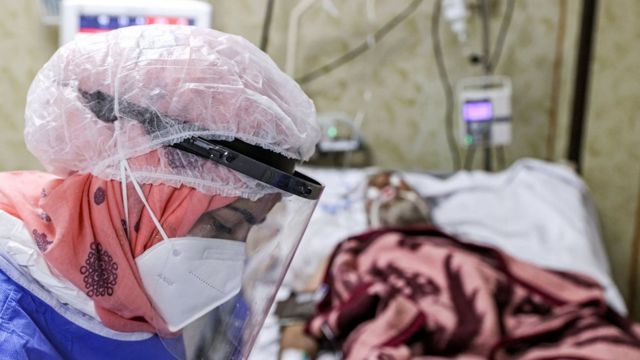
[ad_1]
Healthcare workers in Syria face a great challenge in dealing with successive waves of the epidemic due to the conditions left by the conflict
Medical sources in Syria confirmed on Sunday that hospitals in the capital, Damascus, and the coastal province of Latakia, had reached maximum patient capacity due to the high number of people receiving treatment for the Corona virus.
Tawfiq Hassaba, an official with the Syrian Ministry of Health, said in statements on Syrian state television: “We have started to transfer Covid-19 patients from hospitals in the capital, Damascus, to hospitals in the governorate. of Homs, and to transfer those viruses in Latakia to the hospitals of the governorate of Tartus. “
It comes after “the full capacity of hospitals in these areas has been fully occupied due to the sharp increase in the number of Corona virus cases”.
Syrian health authorities announced on Sunday the discovery of 442 epidemic cases in government-controlled areas, indicating a new record in the country torn by civil war for years.
It is noted that the total number of cases infected with the Corona virus in Syria has reached 32,580 cases, with deaths recorded from the epidemic rising to 2,189 deaths since the start of the epidemic, according to the figures. received from areas controlled by the Syrian government.
The Syrian health ministry official confirmed that this is the first time the number of cases has exceeded 400 in one day.
He pointed out that the governorates of Damascus, Latakia and Aleppo are the governorates that have seen the largest increases in cases in areas controlled by the Syrian government.
Syria has seen a continuous increase in Corona virus cases since mid-August, including parts of the northwest and northeast of the country, and large parts of areas under government control.
The World Health Organization reports that only 2.00 percent of the Syrian population have received vaccines against the Corona virus, between one and two doses.
The armed conflict in Syria began in 2011, killing around half a million people to date, and has led to a sharp deterioration in conditions for the health care sector in the country, which is struggling to resist the epidemic.
There are difficulties in obtaining humanitarian aid, including medical, in several parts of Syria
The suffering of the medical sector
In this sector, Syria suffers from a number of obstacles that make the task of medical personnel working in its territory very difficult due to the continuing armed conflict, which often prevents medical and other humanitarian aid from reaching the country due to opposition from some parties to the conflict and the forces supporting them are entering into medical aid as Russia has done in recent months.
“The lowest common denominator is the lack of supplies, personal protective equipment, oxygen and medical supplies,” Souad al-Jarbawi of the International Rescue Committee said in June.
“The most important thing is that people trust the vaccine … In northeastern Syria, there is no clarity on the vaccine campaign and who will distribute it, and this raises concerns and questions. conspiracy theories … Miraculously, the situation with the Corona virus seems almost under control at the moment. ” .
UN reports have indicated that around 70% of Syrian medical personnel have fled the country since the start of the civil war so far, increasing the difficulty of the current task for those responsible for this sector in Syria. in a context of continued spread of the epidemic. .
Refugee camps in Syria are also one of the most important factors that increase the risk of the epidemic spreading, as these camps lack good living conditions which greatly contribute to the prevention of Corona virus and reduce the risks of the epidemic. infection, which could turn these gatherings into epidemic hotbeds.
In terms of anti-epidemic vaccines, vaccination campaigns with these vaccines face the same obstacles mentioned above as the Syrian medical sector in general.
Source link
